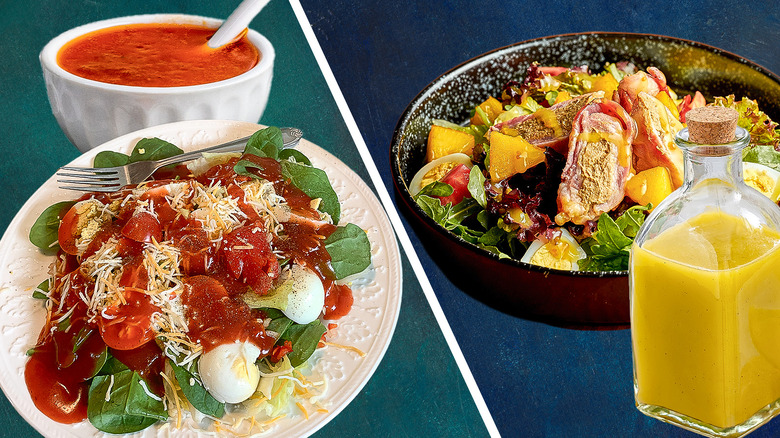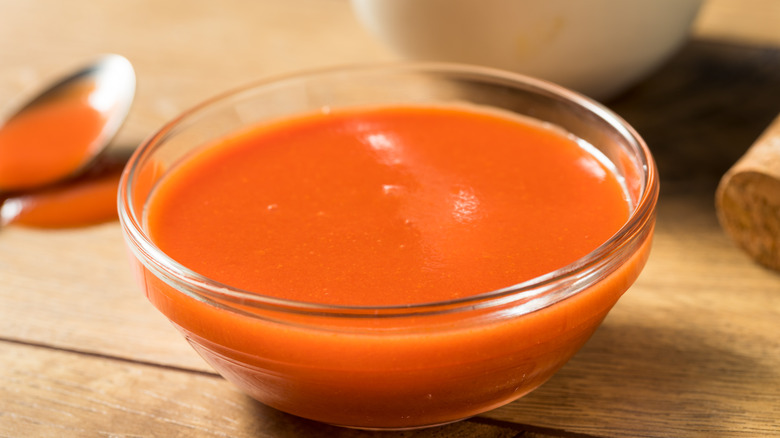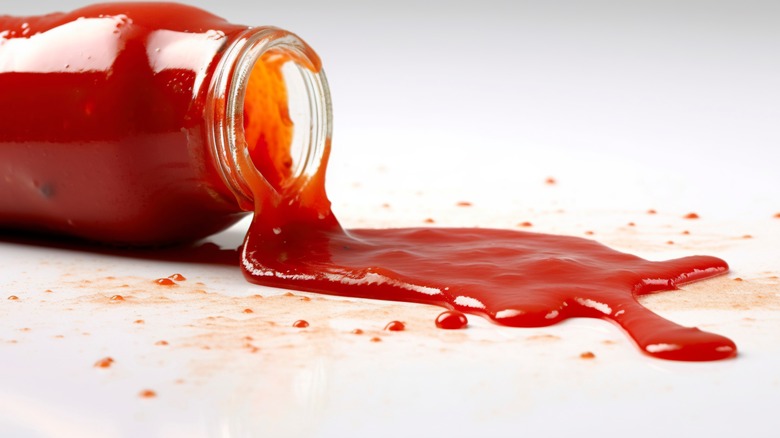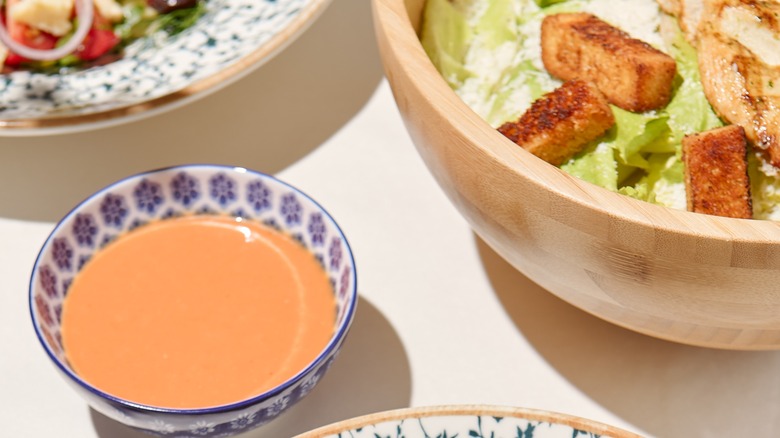Catalina Vs French Dressing: What's The Difference?
Both Catalina and French dressing are zesty condiments that boast similar appearances, each with a bright orange undertone. Plus, they're used in many of the same ways from dressing salads to marinating meats or acting as an impromptu dipping sauce. Not to mention that they're both widely available on supermarket shelves across the country. Yet, despite all of these shared characteristics, Catalina and French dressing are far from being one and the same. The question is, what exactly makes each of the dressings so different?
Regardless of the fact that Catalina and French dressing can usually be swapped for one another with ease, the saucy condiments do bear qualities that make them clearly distinct. They each come from varying origin stories, and offer unique ingredients within their makeup. This impacts their flavor profiles just as much as their textures, but that's only a fraction of what differentiates the two. To ensure that you don't mistake one for the other, it's time that you learned how to distinguish Catalina from French dressing, once and for all!
What is Catalina dressing?
Tangy and sweet, Catalina dressing is a rusty red condiment made with a medley of ingredients like oil and vinegar along with ketchup and sugar. It's also common for additions like a sprinkle of cayenne, a dusting of mustard powder, or even a splash of Worcestershire sauce to be worked into recipes. Given its vibrancy, Catalina dressing is often used to jazz up basic bowls of leafy greens and boring pasta salads, much like it can enhance bland sandwiches and wraps. The dressing also makes a great dip for dunking pizza crusts, and is sometimes brushed over grilled meats as a tasty glaze — its list of applications is really endless.
The origins of Catalina dressing are hard to pin down, however, there are a few theories that lend insight as to how the condiment came to be. Some believe that the dressing was inspired by the bright and bold, sweet-meets-sour flavors that are commonly associated with the Spanish region of Catalonia; it does loosely resemble that of a tomato-y romesco sauce, after all. In contrast, others agree that Catalina dressing was likely an invention of Kraft Foods in the 1960s. One thing is for sure, the creation of Catalina was likely inspired by its predecessor, French dressing.
What is French dressing?
French dressing — as we know it in the U.S. — is a coral-colored sauce based on an emulsion of oil and vinegar that's flavored with a range of add-ins including spices like paprika, garlic, and onion, plus tomato-based products like puree, paste, or ketchup. While it can take the form of a zesty vinaigrette, some recipes also include eggs or mayonnaise. Most notably, flavorful French dressing is the star ingredient to season coleslaws, along with pasta and potato salads. Likewise, it can be used to dress burgers, smother fries, or marinate meats destined for the barbecue.
The details regarding the history of French dressing, much like Catalina dressing, aren't terribly clear. The condiment may be based on the classic French vinaigrette. Traditionally consisting of just fat and acid, the humble vinaigrette eventually evolved to include a variety of seasonings such as mustard and herbs. The orange-hued version can be deemed a byproduct of this evolution; a riff on classic vinaigrette, French dressing is the result of the condiment's journey to the American table.
Moreover, since French dressing was actually the very first flavor to be unveiled by Kraft Foods in 1925, it can be considered the precursor to Catalina dressing. As a result, this explains why the two share so many similarities. But, that isn't to say that they don't have their own unique attributes.
Catalina is brighter and thinner
Although Catalina and French dressing share a host of the same ingredients, ratios are starkly different. Consequently, this has a role in differentiating the two sauces when it comes to color and even texture. Because Catalina tends to consist of a higher amount of ketchup, it boasts a deeper red hue. French dressing tends to be lighter in color given its higher concentration of oil and modest amount of ketchup or tomato-based ingredients. In cases where the dressing contains eggs or mayo, French dressing will have a pale, almost yellow-orange hue.
This difference in ingredient proportions also means that each condiment has a varying viscosity. While Catalina's recipe allows it to take on a thinner and less chunky texture, the same can't be said for French dressing. Not only does the increased amount of fat make the dressing thicker, it also produces a more luscious and velvety mouthfeel. Moreover, the presence of other spices and herbs in French dressing can also impact its thickness.
Regardless of these differences, ketchup enthusiasts are likely to be fans of either dressing. Those seeking bigger and bolder flavors might want to think carefully before selecting one over the other.
French dressing isn't as boldly flavored, but it may be more complex
Based on their differing ingredients and corresponding quantities, Catalina and French dressings have varying degrees of intensity and complexity when it comes to flavor. Although both offer tanginess and sweetness, because Catalina is dominated by punchy ketchup, it tends to have a more acidic profile than its French relative. However, even though Catalina may have a more pronounced intensity due to this prominence of tart ingredients, it isn't always as nuanced as French dressing.
French dressing can include all kinds of savory, sweet, piquant, or smoky spices, which allow it to display layers of (albeit delicate) depth. Consequently, this can play a role in increasing the condiment's overall richness. Plus, because French dressing may be crafted in a creamier style — Catalina is never creamy — this further amplifies its decadence. This doesn't mean that the dressing is any more or less healthy than Catalina, though. After all, Catalina does still contain a generous quantity of sugar in comparison to French dressing.
Catalina or French, the bottom line is that both dressings can offer a significant amount of flavor, texture, and aesthetic. Ultimately, whichever you chose to drizzle onto your favorite dishes is a matter or preference. So, are you Team Catalina or Team French?




